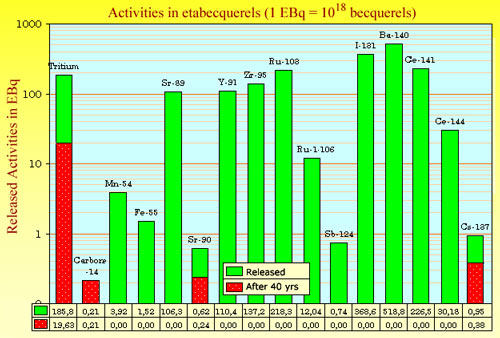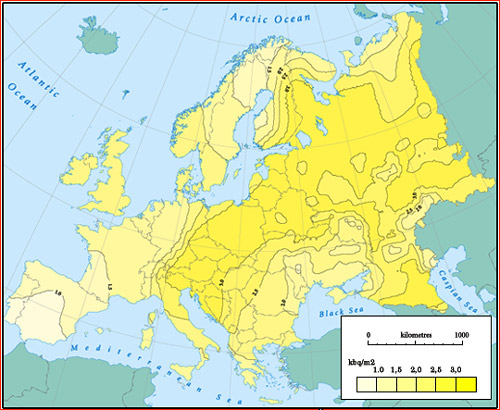A legacy of the cold war

A surplus equivalent to two and half years of natural radioactivity …
The nuclear atmospheric tests have dispersed huge quantities of radioactive elements, as shown by the estimates of the total activities of the main radioactive elements released. The radioactivivity has declined with time. The contaminations (in red) which subsists 40 years after the end atomic trials concerns tritium, carbon-14, strontium-90 and caesium-137. It is considered that humanity has been exposed to the equivalent of two and a half years of natural radioactivity as a result of these tests. (NB: the unity used for these very strong activities is the “etabecquerel”).
© IN2P3
The residue of radioactive contamination which still endures has its origin in the nuclear tests conducted by the Great Powers during the period 1945-1980 as part of the Cold War and the Arms race. The H bombs or hydrogen fusion bombs, although more powerful had less fall out than atomic bombs to start with.
The effects of the radioactivity dispersal have decreased over time. Initially, at the peak of the trials in the 1960s, the annual doses reached 0,100 mSv per year. Today the annual dose is set at 0.005 mSv per year in European countries like Belgium, far from the test sites.

Cesium in Europe before Chernobyl
Legacies of the Cold War, the main radioactive contaminations remaining 40 years after the cessation of atmospheric nuclear tests are due to cesium-137 and to a lesser extent, strontium-90, two radioactive nuclei with half-lives of about thirty years. The map shows the distribution of Cesium-137 deposits in Europe, just before the Chernobyl accident in 1986. Ground contamination was around a kilobecquerel per square meter. Before that date the contamination was divided by about two from the years 1950-60.
© Atlas of Chernobyl
This exposure is low compared to the average 1 mSv received through medical examinations, but contributes to important part of artificial radioactive residue outside the medical field
It is greater than that, released by nuclear power plants and the residual radioactivity of Chernobyl, outside the most affected areas.By far the biggest part of radioactivity coming from powerful explosions are found in the stratosphere, where it remains for around 7 years, before settling three quarters in the Northern hemisphere and one quarter in the Southern hemisphere.
The total collective dose involved as a result of the atmospheric tests has been estimated at 30 Million”man-sievert“. Shared over 5 billion individuals, this represents the equivalent to two and a half years exposure to natural radioactivity, namely around 6.0 mSv per person.

Cesium in Europe after Chernobyl
In 1986, the activity of the cesium-137 released by the Chernobyl accident added to the residue of the impact of atmospheric nuclear tests. The map shows contamination about 1000 times higher near Chernobyl compared to western Europe because of distance. Globally the amount of Chernobyl releases totaled about three times the residual activity in 1986 of the nuclear tests.
© IRSN
In terms of activity, the main radioelements subsisting are : tritium (spread in abundance by the hydrogen bombs), carbon-14, caesium-137 and strontium-90. In terms of effective doses, the main contributor is carbon -14 (70%), followed by caesium-137 (13%). The contamination due to tritium and carbon-14, radioelements produced also by cosmic rays, are of little concern .
Because of its half-life of 5730 years, the carbon-14 released by nuclear tests will vanish very slowly … and may disrupt the future radiocarbon-14 dating performed by our descendents. One estimates to around 2% the excess resulting from atmospheric testings with respect to radiocarbon produced by cosmic rays.
Limited attention is paid to tritium, which have a very low radiotoxicity and vanishes with an half-life of 12 years. More worrying are cesium-137 and strontium-90 which have an half-life of around last 30 years.
Other articles on the subject « Accidental Releases »
Atmospheric Releases
Atmospheric radioactive pollution after a major accident During a major accident, radioactive mat[...]
Risks of ground deposits
Two deposition modes: dry deposits and wet deposits In ordinary life, apart from the vicinity of [...]
Risks of Internal Exposure
After an accident : what impact on food and man ? A large amount of radioactivity was dispersed i[...]
Exposition modes (accident)
What are the exposition pathways after a major accident ? What is the impact on man of a major re[...]